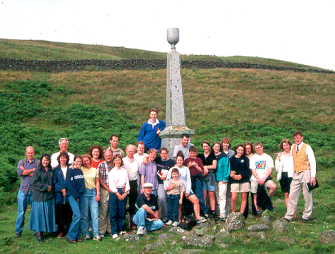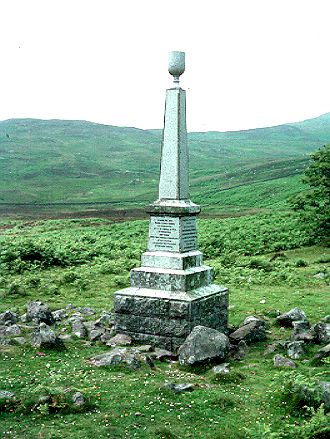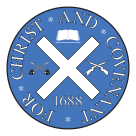Communion Stones
The Communion Stones are a number of large boulders arranged in worship format, where Covenanters met to hear sermons from visiting ministers, and where the sacraments were dispensed. The monument alongside was raised by public suscription, the original appeal being issued in 1870, but the memorial was not erected until 1872.
It is said that one of the services held there in 1678 had 6,000 in attendance, with around 3,200 being served communion. At this service, which was conducted by Rev John Welsh, it is said that the communion vessels from Irongray kirk were used, after which they were concealed somewhere in the neighbourhood and lost. The kirk session records of 1697 note, ‘The several members of this judicatory, having made search after the utensils of this church, can hear nothing anent them, only that they were carried away with Mr John Welsh, his plenishing.’

Communion Stones
Skeoch Hill
Irongray
Kirkcudbrightshire
NGR - NX 859790
The memorial at the Communion Stones is remotely located on a hillside, and thus visitors need to be fit enough to climb to it. Various routes are possible, one of the more common being from Threepneuk and Scaur farm to the south, from where a track ascends part of the route. It is advised to have an Ordnance Survey map if planning to visit.
Inscription:
TO MARK THE SPOT
WHERE A LARGE NUMBER
OF COVENANTERS
MET IN THE SUMMER OF 1678
TO WORSHIP GOD
AND WHERE
ABOUT THREE THOUSAND COMMUNICANTS
ON THAT OCCASION
CELEBRATED THE SACRAMENT
OF THE LORD'S SUPPER
[North side]
THE FOLLOWING EJECTED MINISTERS
OFFICIATED
JOHN WELSH OF IRONGRAY
JOHN BLACKADDER OF TROQUEER
JOHN DICKSON OF RUTHERGLEN
AND SAMUEL ARNOT OF TONGLAND
THE ADJACENT STONES
BEING USED
AS THE COMMUNION TABLE
[West side]
THESE STONES
ARE SIGNIFICANT MEMORIALS
OF THOSE TROUBLOUS TIMES
IN WHICH OUR FATHERS
AT THE PERIL OF THEIR LIVES
CONTENDED FOR GREAT PRINCIPLES
OF CIVIL AND RELIGIOUS FREEDOM
[South side]
ERECTED BY
VOLUNTARY SUBSCRIPTION
IN 1870

Memorial Controversy
A proposal to erect a monument on the site had been made by James Johnston and seven others. They commenced collection subscriptions and as the money built up they started to plan what the monument should be like and what the inscription would say. The latter part seems to have caused some issue, and the eight men were divided five/three. The minority group made a public appeal, and arranged for a public meeting to be held to progress the matter. The meeting of subscribers to the monument was held on the evening of 20 September 1869. Subscribers from Irongray, Lochrutton and Dumfries attended, where an inscription prepared by John Crocket, with a few alterations, was adopted unanimously. A committee of eight was then formed, with representative of the different church congregations in the area represented—Established Church, Free Church, United Presbyterian Church and Reformed Presbyterian Church. They were tasked with meeting the landowner to ask for his permission to erect the monument.
However, permission was refused, and as a result the committee had to organise another public meeting to see what to do next. This meeting took place at Shawhead on 13 January 1870. At this meeting a letter was out from Messrs. D. H. and J. Newall of Dalbeattie, dated 6 January 1870, stating that ‘Mr MacKnight and three other gentlemen called on Tuesday last, and paid us for the monument, not including the inscription’. The letter from the landowner was also read, which indicated that he was refusing the erection of the monument bearing the inscription ‘unanimously adopted at the meeting of subscriber’, but would allow its erection with the inscription proposed by the five members of the original committee. It continued saying that the proprietor objected to the subscribers’ inscription, ‘in respect that it states the monument to be erected to the memory of certain parties, [whereas it was only] to mark the spot where the communion was held, and as a memorial of that historical event, and of the circumstances connected with it, so far as they can be ascertained’.
Mr Welsh of Scaur (or Skarr, as it appears in the paper) offered a site within a few hundred yards of the Communion Stones, and the meeting agreed by 49 to 19 that it should be accepted. With some slight alterations, the inscription was agreed on: In memory of our revered ancestors, the Covenanters of Scotland, who testified and suffered for Christ’s Crown, and the spiritual independence of His church, when Charles II attempted by royal authority to abolish Presbyterianism and plant episcopacy on its ruins.’
A committee of thirteen ws then appointed, including the all of the members of the original self-constituted committee, to continue the work of erection. Aware of some dissent, it was announced that ’any subscriber who may not be satisfied with the above resolution shall receive his subscription back on application’.
This new committee met on 28 January 1870, although none of the original five attended, despite being invited. Instead, they went to Dalbeattie to collect the monument which they had paid for with subscribers’ money. The tenant of the land where it was proposed to erect the monument warned them against trespass, resulting in the stone being left at the gate at the roadside.
The main committee applied to the treasurer, Thomas Maxwell in Cornlee, to return the balance to the committee. Application was also made to the agent of the other party to return the money subscribed by 274 contributors, as per the agreement of the meeting on 13 January, totalling £30 17s 11d. This figure was just short of the £32 cost of erecting the monument. The funds were never returned. Instead the monument with the inscription noted at the start of the article was erected.
Five gentlemen had arranged for the monument to be made, and to incorporate an inscription which was in defiance of the expressed wishes of the bulk of the subscribers.
Eventually, on 24 January 1872, Rev Alexander Grierson, of the Free Church of Irongray, wrote a letter to the Dumfries & Galloway Standard outlying the story so far. He concluded by saying that ’but as their [the subscribers] object has not only been defeated but reversed; and one of the handsomest monuments of the kind in Scotland put up at their expense with an inscription which represents them as responsible for its errors in grammar, its vain repetitions, its questionable statements, its exaggeration, its self-contradiction, its suppression of the principles of the Covenanters, and above all the statement it bears on its front, “Erected by voluntary contribution”, I hereby publicly, and in name of 274 subscribers repudiate it. Let those who have put it there, mainly at the expense of these subscriber, but in defiance of their expressed wishes, share the honour of it among themselves. We shall have none of it. Whether some more permanent repudiation may not be necessary, it is for the subscribers themselves to say’.
The Dumfries and Galloway Natural History and Antiquarian Society paid a visit to the memorial on 6 June 1872 when they referred to the ‘controversy’ of the memorial’s erection, and noted that ‘but until this kind of vandalism was perpetrated, it might have been said that the hand of time, as well as the hands of man, had dealt gently with these interesting memorials.’






